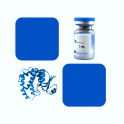
- Remove this product from my favorite's list.
- Add this product to my list of favorites.
Products
Viewed products
Newsletter
 |  |  |  |  |  |

Background
Cluster of differentiation 14 (CD14), is a cell surface glycoprotein, and is a is a component of the innate immune system. CD14 is a myelomonocytic differentiation antigen preferentially expressed on monocytes, macrophages, and activated granulocytes. CD14 exists in two forms. Either it is anchored into the membrane by a glycosylphosphatidylinositol tail (mCD14) or it appears in a soluble form (sCD14). Soluble CD14 either appears after shedding of mCD14 (48 kDa) or is directly secreted from intracellular vesicles (56 kDa). CD14 acts as a co-receptor (along with the Toll-like receptor TLR 4 and MD-2) for the detection of bacterial lipopolysaccharide (LPS). CD14 can bind LPS only in the presence of lipopolysaccharide-binding protein (LBP). CD14 has been proposed to be involved in various biological processes, including transportation of other lipids, cell-cell interaction during different immune responses, as well as recognition of apoptotic cells. Although LPS is considered its main ligand, CD14 also recognizes other pathogen-associated molecular patterns. CD14+ cells are monocytes that can differentiate into a host of different cells. CD14 has been shown to interact with Lipopolysaccharide-binding protein.
Source
Recombinant human CD14 (rhCD14), His Tag (CD4-H5228) is expressed from human 293 cells (HEK293). It contains AA Thr 20 - Met 344 (Accession # AAH10507).
Predicted N-terminus: Thr 20
Molecular Characterization
This protein carries a polyhistidine tag at the C-terminus.
The protein has a calculated MW of 35.9 kDa. The protein migrates as 40-53 kDa under reducing (R) condition (SDS-PAGE) due to glycosylation.
Endotoxin
Less than 1.0 EU per μg by the LAL method.
Purity
>98% as determined by SDS-PAGE.
>90% as determined by SEC-MALS.
Formulation
Lyophilized from 0.22 μm filtered solution in PBS, pH7.4. Normally trehalose is added as protectant before lyophilization.
Reconstitution
See Certificate of Analysis for details of reconstitution instruction and specific concentration.
Storage
For long term storage, the product should be stored at lyophilized state at -20°C or lower.
Please avoid repeated freeze-thaw cycles.
This product is stable after storage at:
-20°C to -70°C for 12 months in lyophilized state;
-70°C for 3 months under sterile conditions after reconstitution.
Bioactivity
Please refer to product data sheet.
(1) "Reproducible isolation of bovine mammary macrophages for analysis of host pathogen interactions"
Tomes, Archer, Leigh
BMC Vet Res (2024) 20 (1), 96
(2) "Strictosamide alleviates acute lung injury via regulating T helper 17 cells, regulatory T cells, and gut microbiota"
Wu, Zhang, Mai et al
Phytomedicine (2024) 128, 155490
(3) "IL-18 and CD14 variants in chronic HBV predisposition: a case-control study with in silico analyses focused on transcription and splicing"
Sarhadi, Pahlavani, Hosseini Razavi et al
Nucleosides Nucleotides Nucleic Acids (2024)
Showing 1-3 of 29770 papers.
Follow us